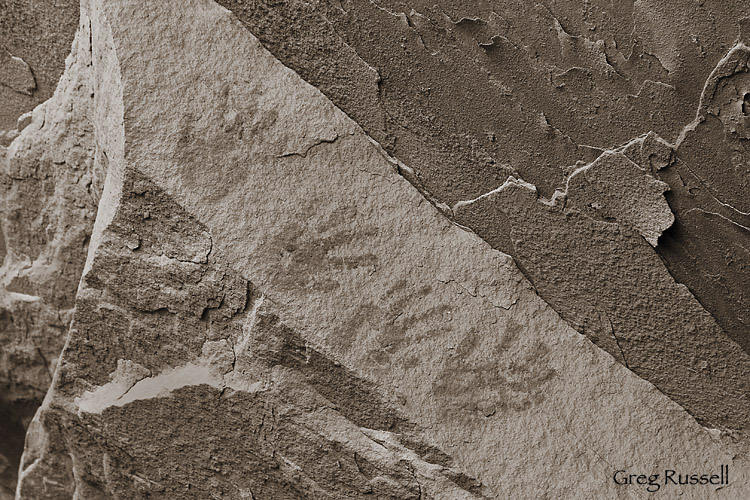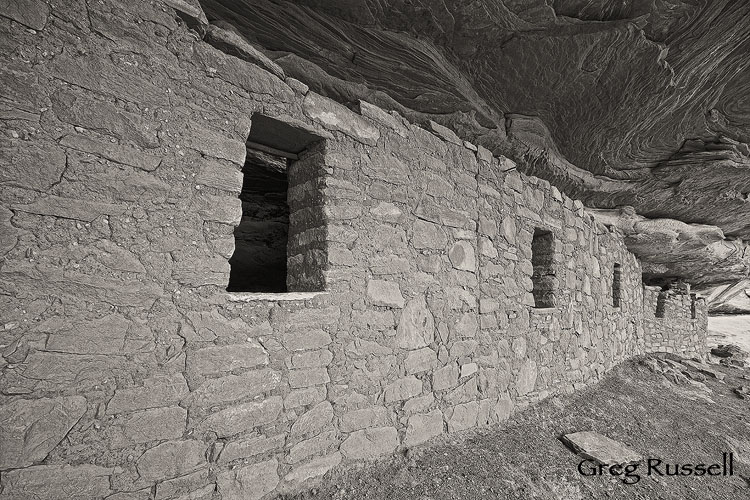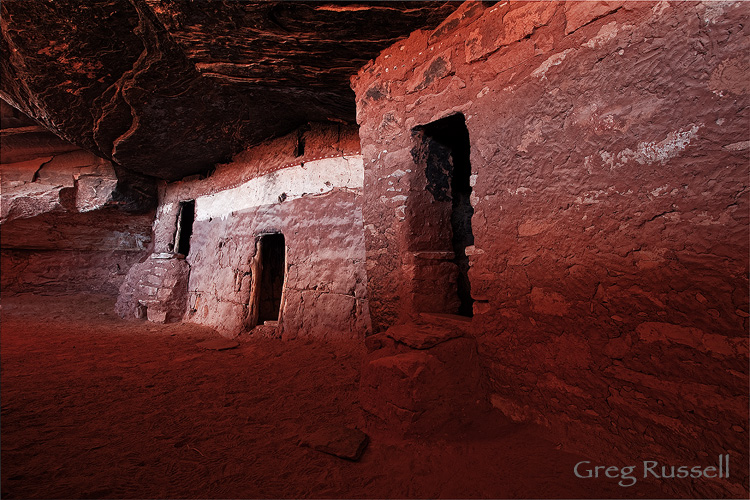For August in the Southwest, the air is unusually humid. Dark clouds are rolling in from the west as we walk into the wide, shallow canyon. A narrow trails has been worn in the horsetail reeds; they rise up past my waist and I put my hands out, letting my fingers run along their tips. The leaves of the cottonwoods that dot this canyon are moving faster and the cool air of the incoming thunderstorm acts as a natural swamp cooler. After about twenty minutes of walking, I look up onto a sandstone outcropping and see what I’ve came here to visit–an 800-year-old Ancestral Puebloan ruin nestled into the cliff.
I’ve returned to this area of southeastern Utah for my first significant visit in nearly 15 years. Growing up, my Dad and I spent many hours backpacking the wild canyons of Cedar Mesa, and for the last several years, I’ve longed to come back for a visit. My motivations for returning–I suppose–are many. I’ve returned to slow down, hoping to escape the nonstop movement in southern California. Similarly, I have returned to revisit my past; as an adolescent, I have suddenly realized that I took many of my early wilderness experiences for granted. Photographic motivations also played a role–I want images of these places that define me.
I think, ultimately, I’ve returned because this is my epicenter: this is the place I fell in love with the Colorado Plateau. Light-colored Cedar Mesa sandstone with its bold desert varnish seemed to always be a part of my early wilderness experiences. Its is part of me–occasionally when I accidentally cut myself, I look closely at the blood, perhaps hoping its become the color of the Organ Rock or Moenkopi shales that top the Cedar Mesa formation. I’ve come back to pay reverence to the natural and cultural history of this landscape.

Paul Woodruff describes reverence as a virtue; the more reverence you have, the greater your capacity to feel respect, awe, shame. As a visitor to the canyons of Cedar Mesa, all of these emotions are evoked inside of me. I feel a deep respect for the Ancestral Puebloan people who settled here, multiple times, to make a living. Although the landscape was likely different centuries ago, it was still a hot, dry place, but they made a living, farming the verdant canyons and carving out a life on the cliffs. The work that went into these structures is tangible–look closely and you can see ancient finger and palm prints in the dried mud of their walls. The forces that shaped this labyrinth of canyons are nothing less than awe-inspring.
Yes, one even can feel shame here, although it isn’t necessarily a bad thing. I am ashamed I didn’t appreciate my early visits more, that I am just now realizing the full impact of the history available to us up on this small mesa in lovely, remote southeastern Utah. Indeed, for the individual willing to open his heart and mind (and sometimes to close his mouth), these canyons can speak to you.



I’m sure it’s hard for some to relate to your post Greg, but I’m not one of them. I can vividly remember an afternoon spent at Turkey Pen Ruin, feeling the presence of the Anasazi and half expecting them to return at any moment.
Cedar Mesa is a wild and sacred place and I hope it always remains that way. Your images tell the story well.
Thanks for the comment, Russ. I really appreciate you sharing your experiences on Cedar Mesa. Yes, it is a special place indeed–one of the finest in North America, IMHO.
Yes, I believe many of us have our own “epicentres” an excellent phrase. I feel visits to the Scottish highlands with more poignance, than anywhere else, and have yet to take any photographs there.
Somehow I still feel that I am not ready! I think this is your “reverence”
An excellent read, well written. I have been so swamped with releasing the new ebook and planning the move to Thailand, I haven’t had any time to write further thoughts on my own blog, where we began to discuss a similar line of thought…
best wishes
Alister, your previous blog post couldn’t have come along at a better time, since I have been pondering this post since before then. Your ideas were a great catalyst to help me crystallize some of my own.
Your blog post (http://availablelightimages.com/blog/2011/08/24/memories/) might be of interest to people here who aren’t familiar with your work! Your writings and images are always very insightful and inspirational.
Well written Greg, thanks for sharing your thoughts.
Thanks, Alan. I really appreciate it!
Excellent post. I think everyone has their ‘epicenter’ as you call it, and the more you are exposed to the wild earth the more you recognize and appreciate your own. Unfortunately most of us are so divorced from any meaningful contact with the wild that we are oblivious, we feel no connection to any place. We’re not rooted, we’re scattered, we have no sense of reverence like you describe. That’s a sweeping generalization of course, but I think it’s a serious problem in our modern society.
I think the biggest problem you note is that lack of reverence, PJ. In the book I linked to–by Paul Woodruff–he discusses the notion that reverence is noticeably missing from our society. Not only in terms of wilderness, but in all aspects of our society.
As you and I have discussed here and via email, trying to live a mindful life, one that’s conscious of the existence and importance of wilderness is of paramount importance–especially now!
Very, very well said. And beautifully photographed. I do wish more people could understand and feel the same sort of reverence for place that Cedar Mesa evokes in you. It seems that too few people, these days, have or share their own memories of the places that define them, as you aptly put it.
Thanks for the comment, and for reading my post, Julie! Yes, I agree that the places that define people are part of that integral patchwork of maintaining a viable culture, but it is falling by the wayside.
Like I said to PJ above, living a mindful life is about the best any of us can do.
Very thoughtful. In Welsh we have a word “hiraeth”, which has no direct English equivalent. Wikipedia says it means: “a mix of longing, yearning, nostalgia, wistfulness, and the earnest desire for the Wales of the past.” I am not sure whether that all adds up to reverence but it is close in my mind. I live in Hong Kong but my heart will always be in Wales.
Thanks for this really thoughtful comment, Andrew. I would say that hiraeth adds up to something close to Woodruff’s definition of reverence…at least in my mind it does.
Awesome post, Greg. I was very moved reading it.
I have a question – the picture of the hands…are those hands carved into the stone or stained or what? I’ve never seen pictographs in person.
Sharon
Many thanks, as always, Sharon for your comments.
Yes, those handprints are painted onto the rock. What the artist likely did was dip his/her hand in paint and just did a bit of “fingerpainting” as it were. The ones in this post are “positive” handprints. Image #0463 on this page:
http://www.alpenglowimagesphotography.com/landscapes/utah/cedar_mesa/cedar_mesa.html
is a “negative” handprint. The artist put his/her hand on the rock, then using a reed or something else, blew paint over their hand, leaving the silhouette of it on the rock.
These are fine images. I especially like the last one for the mood it evokes. Your text is very nicely written. I chuckled at the sentence:
“Indeed, for the individual willing to open his heart and mind (and sometimes to close his mouth), these canyons can speak to you.”
These virtues have all become a bit tarnished in our modern era of chatter through electronics.
Thanks, David. 🙂 That sentence was really just a mental note to myself that I need to shut up once in a while.
Thanks so much, Greg. I wondered how they were done. I guess we would get arrested for doing that now…
Sharon
Haha…yes, well I guess in some ways this was ancient graffiti. Perhaps in 700 years, what graffiti from our current world that survives will be looked upon differently.
Hi Greg. Sorry I haven’t commented. I read this a few days ago and thought I had. Ah well, that’s old age catching up with me. 🙂
I really enjoy your writing. Although I can’t put words together as you do so well, I definitely can identify with your sentiments about the source for our inspiration. Several years ago I found the little cabin in the Adirondacks that my grandparents had owned when I was a child and wandered in the woods discovering flowers, insects and trees. Unlike the wonderful historic and protected area in your essay, it had changed greatly and was being developed. But visiting it still rekindled some emotions from childhood.
There’s no need for you to feel any shame….the child can never sense the larger picture and appreciate these things.
Thanks for reminding me of that feeling of awe and for sharing your poignant thoughts.
As a child, you experience everything at a different level. It’s called innocence. Only with age do we begin to “see” the world differently. I don’t know if that is good or bad, it is just the way it is.
Regret maybe, at some sense of not appreciating an early experience, but not shame. You did nothing wrong.
Very nice images. I like the toning.
Great blog. Wonderful photography and stirring prose. Thanks for sharing.
Thanks for the kind words, and for stopping by, Steven! I appreciate it…